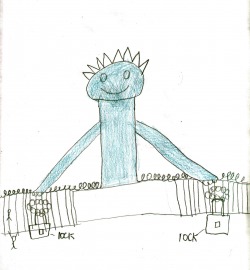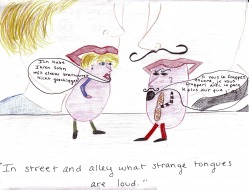Okay, admittedly it took quite a while to put the different pieces of this project together, but my 8th Grade Social Studies classes have just finished with an unbelievably, mind-numbingly, chew-on-the-carpet, kick-butt project. (Umm... in other words, the kids did a really good job on this.)
If you'll indulge me, let me tell you a story:
Our Immigration Unit is designed to make students think critically about an important, emotionally-charged issue and decide what THEY think based on facts, rather than what their parents or friends or teachers think. Our Essential Question for the unit is, "Who Deserves to Be an American?" (This is phrased deliberately provacatively.)
As part of this unit, the students look at a series of somewhere between 40-50 political cartoons from the early 1800s to present dealing with immigration. The kids are really good at picking out details in a these pictures and speculating about what they mean. By the time we have spent three or four class periods interpreting political cartoons, they usually have a really good grasp on political symbolism.
The next stage of the unit is looking at two poems written at roughly the same period in American history - Emma Lazarus' "The New Colossus" (the "Statue of Liberty Poem"), which was very supportive of the idea of new immigrants, and "The Unguarded Gate" by Thomas Bailey Aldrich, which took a much dimmer view of immigrants and the danger he thought they posed to American culture.
Now, this can get pretty hairy. Victorian poetry is awfully dense stuff at the best of times and Aldrich's poem is pretty ornate, even by the standards of the time. In past years, I've asked the students to translate these poems into modern American English. This was a mixed success at best. Really good students who liked working out puzzles did pretty well, but most of them just sort of closed their eyes and "punted" and really didn't learn much from the experience. This year, I decided to try another approach:
I had each student pull a colored poker chip from a jar (the Awesome Jar of Destiny - Da Da DAAAAAHHHHH!!) [Don't worry if you don't get the reference.]. Students with one color were assigned to draw a political cartoon expressing the point of view from Emma Lazarus’ poem. Students who pulled the other color were assigned to draw a cartoon from Aldrich’s point of view.
The cartoons I got back were stunning.
No. Seriously. They were really, really good. Professionally good, in some cases. So good, in fact, that I felt that they really needed to be brought to a wider audience. Here's what I did:
I scanned each cartoon, creating a digital image (a jpeg file) and put each class' work into a separate folder.
In class, using our classroom projector, we opened up PowerPoint and used the Photo Album function to drop all the student artwork into a presentation. It automatically created a title page slide, which we changed to suit the class' tastes. We also quickly highlighted all the slides with cartoons and formatted them to have a neutral color in the background.
Using a TuneTalk recording device and an iPod, student volunteers recorded descriptions for each of the following slides –
1. An explanation of “The New Colossus”,
2. A reading of the actual poem,
3. An explanation of Thomas Bailey Aldrich’s point of view,
4. A reading of his poem,
5. An explanation of the cartoon project.
Next, we edited each clip in Audacity, taking out all the pauses and mistakes. (Once each clip was edited and saved, the students loved hearing what it sounded like at a much higher or much lower pitch - the "chipmunk" or "kidnapper" versions.)
As a class, we searched for images to go with each commentary online and built slides with the images and the .wav files. The student whose voice was used on a given slide was given a lot of creative control over what the slide would look like and how it would run. Text could remain static for instance, or appear gradually, using the Wipe function. If he or she wanted it to appear gradually, the class needed to look at how many seconds the sound file took to play, then set the Wipe to run in that many seconds.
Each class picked a piece of music to play in the background, while the slides of their cartoons runs. They needed to calculate the number of seconds that the song was, then divided that by the number of slides that would run during the song. Then, as a class, they selected all those slides and set the animation to advance each of those slides automatically at that interval. (Less complicated than it sounds.)
Later on, I (maybe next year, it can be a student) played the PowerPoint and recorded it with AutoScreenRecorder, then used Microsoft MovieMaker to convert it to a movie file. The sound does not record with AutoScreenRecorder, so I ended up dragging and dropping the individual sound files that the kids had recorded into Movie Maker. Because I had recorded the PowerPoint in real time, they matched up more or less perfectly. I ended up with a video file that I was able to upload to our school server and to TeacherTube.
I'm really proud of th.


 RSS Feed
RSS Feed